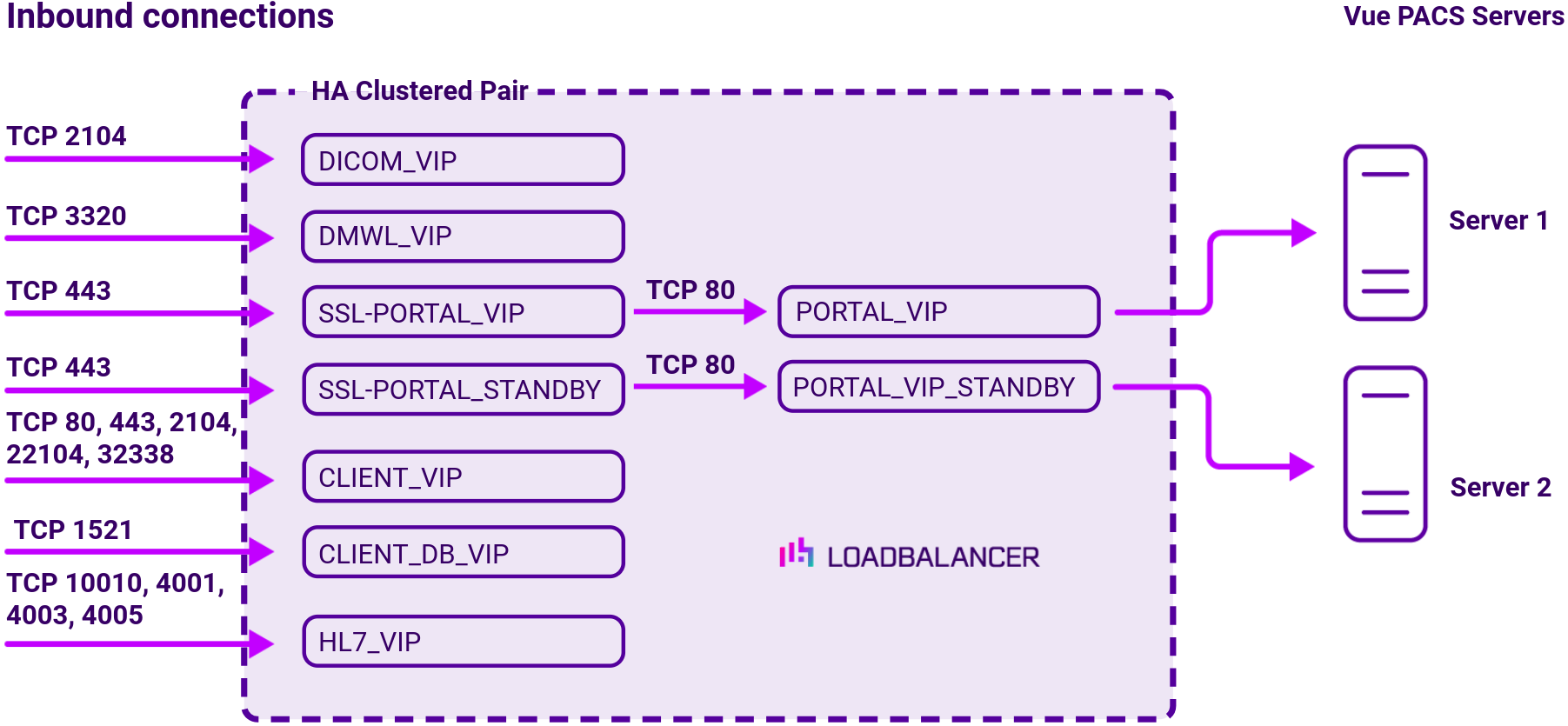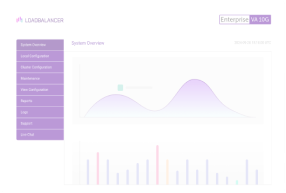Load balancing Philips Vue PACS
Benefits of load balancing Philips Vue PACS
The three main benefits of implementing load balancing for Philips Vue PACS are:
- High Availability (HA): Load balancing prevents a single point of failure. If one PACS server fails or needs maintenance, the load balancer automatically redirects traffic and critical medical imaging studies to the remaining healthy servers. This ensures continuous workflow availability and minimizes downtime, which is crucial in a healthcare environment where image access can be life-critical.
- Optimized performance: By intelligently distributing incoming DICOM traffic and workload across multiple servers, load balancing ensures that no single server becomes overwhelmed or creates a bottleneck. This results in faster processing and delivery of imaging studies, which improves the overall responsiveness of the system and accelerates workflows for radiologists and clinicians.
- Scalability and resource utilization: Load balancing allows the system to easily scale to accommodate increasing data volumes and user demands. New servers can be added to the PACS infrastructure, and the load balancer will automatically include them in the traffic distribution. This ensures optimal use of all available computing resources and prevents the threat of technology obsolescence as data grows.
Load balancing solutions specifically designed for DICOM data, which is used by Philips Vue PACS, often use customized algorithms to route imaging studies based on factors like study size, modality type, or priority (e.g., routing urgent emergency studies to the least-busy server). This application-level intelligence enhances the general benefits of load balancing in a medical imaging context.
About Philips Vue PACS
Philips Vue (Picture Archiving and Communication System) PACS is an image-management platform that provides scalable local and wide area PACS solutions for hospitals and related institutions.
The technology allows hospital systems to archive, distribute, display and retrieve images and data from all hospital modalities and information systems.
Why Loadbalancer.org for Philips Vue PACS?
This deployment guide isn’t theoretical; it has been field tested and rigorously validated by Philips Healthcare experts. This means you can be completely confident that the solution described is robust, reliable, and backed by the real-world operational experience of a global leader in healthcare technology.
Loadbalancer’s intuitive Enterprise Application Delivery Controller (ADC) is designed to save time and money with a clever, not complex, WebUI.
Easily configure, deploy, manage, and maintain our Enterprise load balancer, reducing complexity and the risk of human error. For a difference you can see in just minutes.
And with WAF and GSLB included straight out-of-the-box, there’s no hidden costs, so the prices you see on our website are fully transparent.
More on what’s possible with Loadbalancer.org.
How to load balance Philips Vue PACS
The load balancer can be deployed in 4 fundamental ways: Layer 4 DR mode, Layer 4 NAT mode, Layer 4 SNAT mode, and Layer 7 Reverse Proxy (Layer 7 SNAT mode).
For Philips Vue PACS, both Layer 4 DR mode and Layer 7 Reverse Proxy (Layer 7 SNAT mode) are used.
Virtual service (VIP) requirements
To provide load balancing and HA for Philips Vue PACS, the following VIPs are required:
| Ref. | VIP Name | Mode | Port(s) | Persistence | Health Check |
|---|---|---|---|---|---|
| VIP 1 | DICOM_VIP | Layer 7 Reverse Proxy | 2104 | Source IP | Connect to Port |
| VIP 2 | DMWL_VIP | Layer 7 Reverse Proxy | 3320 | Source IP | Connect to Port |
| VIP 3 | PORTAL_VIP | Layer 7 Reverse Proxy | 80 | Source IP | External Script |
| VIP 3-B1 | CHAT | Layer 7 Reverse Proxy | – | None | HTTPS (GET) |
| VIP 4 | PORTAL_VIP_STANDBY | Layer 7 Reverse Proxy | 80 | Source IP | External Script |
| VIP 4-B1 | CHAT_STANDBY | Layer 7 Reverse Proxy | – | None | HTTPS (GET) |
| VIP 5 | CLIENT_VIP | Layer 7 Reverse Proxy | 80,443,514,2 104,22104,32 338 | Source IP | Connect to Port |
| VIP 6 | CLIENT_DB_VIP | Layer 7 Reverse Proxy | 1521 | Source IP | Connect to Port |
| VIP 7 | HL7_VIP | Layer 7 Reverse Proxy | 10010,4001,4 003,4005 | Source IP | Connect to Port |
Load balancing deployment concept

About Layer 4 DR mode load balancing
One-arm direct routing (DR) mode is a very high performance solution that requires little change to your existing infrastructure.

DR mode works by changing the destination MAC address of the incoming packet to match the selected Real Server on the fly which is very fast.
When the packet reaches the Real Server it expects the Real Server to own the Virtual Services IP address (VIP). This means that you need to ensure that the Real Server (and the load balanced application) respond to both the Real Server’s own IP address and the VIP.
The Real Servers should not respond to ARP requests for the VIP. Only the load balancer should do this. Configuring the Real Servers in this way is referred to as Solving the ARP problem.
On average, DR mode is 8 times quicker than NAT for HTTP, 50 times quicker for Terminal Services and much, much faster for streaming media or FTP.
The load balancer must have an Interface in the same subnet as the Real Servers to ensure Layer 2 connectivity required for DR mode to work.
The VIP can be brought up on the same subnet as the Real Servers, or on a different subnet provided that the load balancer has an interface in that subnet.
Port translation is not possible with DR mode, e.g. VIP:80 → RIP:8080 is not supported. DR mode is transparent, i.e. the Real Server will see the source IP address of the client.
About Layer 7 Reverse Proxy load balancing
Layer 7 Reverse Proxy uses a proxy (HAProxy) at the application layer. Inbound requests are terminated on the load balancer and HAProxy generates a new corresponding request to the chosen Real Server. As a result, Layer 7 is typically not as fast as the Layer 4 methods.
Layer 7 is typically chosen when enhanced options such as SSL termination, cookie based persistence, URL rewriting, header insertion/deletion etc. are required, or when the network topology prohibits the use of the Layer 4 methods.

Because Layer 7 Reverse Proxy is a full proxy, any server in the cluster can be on any accessible subnet, including across the Internet or WAN.
Layer 7 Reverse Proxy is not transparent by default i.e. the Real Servers will not see the source IP address of the client, they will see the load balancer’s own IP address by default, or any other local appliance IP address if preferred (e.g. the VIP address). This can be configured per Layer 7 VIP.
If required, the load balancer can be configured to provide the actual client IP address to the Real Servers in two ways:
- Either by inserting a header that contains the client’s source IP address, or
- By modifying the Source Address field of the IP packets and replacing the IP address of the load balancer with the IP address of the client.
Layer 7 Reverse Proxy mode can be deployed using either a one-arm or two-arm configuration. For two-arm deployments, eth0 is normally used for the internal network and eth1 is used for the external network, although this is not mandatory.
No mode-specific configuration changes to the load balanced Real Servers are required.
Port translation is possible with Layer 7 Reverse Proxy e.g. VIP:80 → RIP:8080 is supported. You should not use the same RIP:PORT combination for Layer 7 Reverse Proxy VIPs and Layer 4 SNAT mode VIPs because the required firewall rules conflict.


















